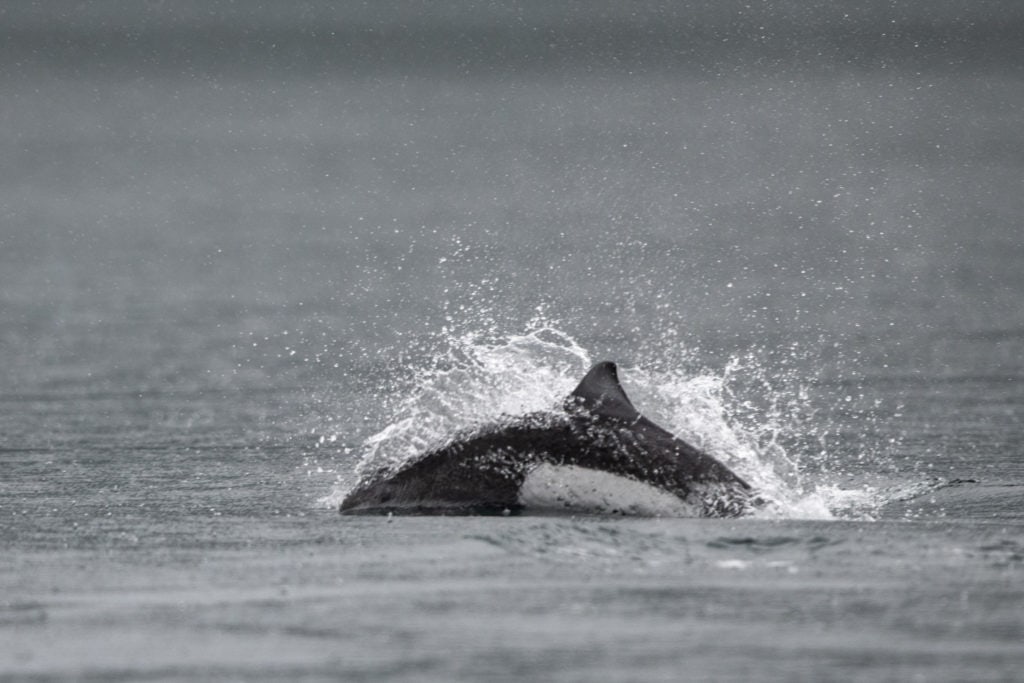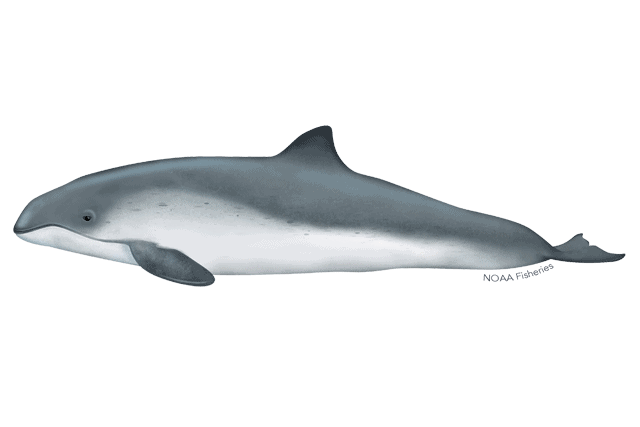Porpoise are small-toothed whales that are closely related to dolphins. They can be differentiated by their teeth, which are spade-shaped opposed to cone-shaped, their dorsal fins, which are triangular, and their beaks, which are less elongated. While there are said to be 32 different dolphin species in the world, there are only 6 different types of porpoises! In the Campbell River area, we are lucky enough to be able to see two of them: The Dall’s and the Harbor Porpoise.
Dall’s Porpoise:
- This type of porpoise has a few distinct physical features: they have a thick body, are black and white so they’re commonly mistaken as baby Orca, but they do not have white eye spots.
- The average size of a Dall’s is 6 feet long and about 440 lbs.
- They typically travel in group sizes between 2 and 20.

Photo Credit: NOAA Fisheries - Dall’s Porpoise are commonly found bow-riding and surfing in boat wakes, which is a similar characteristic of the Pacific White-Sided Dolphins and they have been found socializing with them
- You can identify a Dall’s by the rooster tail splash they make when they travel at high speeds
- Their travel speeds can reach up to 34 mph which makes them one of the fastest small cetaceans!
- You won’t find a Dall’s Porpoise leaping out of the water. They are rarely acrobatic.
- Their diets consist of small schooling fish, such as herring
- They have an average lifespan of 13 years. All porpoises have short lifespans and very few of them live up to or over 20 years.
Harbor Porpoise:
- They can be identified by their dark grey bodies with white bellies
- These porpoises have been seen migrating between coastal waters and offshore areas. However, they prefer shallow waters.
- Significantly smaller than the Dall’s, the Harbor Porpoise have an average length of 5.5 feet and weigh about 170 lbs. They are the smallest cetacean in BC!

Photo Credit: NOAA Fisheries - Unlike other porpoises, they have a blunt rounded snout instead of a beak.
- They consume about 10% of their body weight per day and eat small schooling fish, like herring.
- These porpoises won’t be seen bow-riding or socializing with other cetaceans. Harbor porpoises are shy and tend to avoid boats. It’s not uncommon to come across one only to have it completely disappear rapidly!
- Harbor Porpoises don’t bring their entire bodies out of the water when swimming

While the Harbor and Dall’s Porpoise have several differences, there have been a few hybrids spotted! According to wildwhales.org, “Hybridization between Dall’s Porpoise and Harbor Porpoise occurs occasionally in BC waters with Harbor Porpoise as the paternal parent and Dall’s Porpoise as the maternal parent. Hybrids tend to appear more similar to Dall’s Porpoise in body shape, diving characteristics and behaviour, but they lack the white side patches and the colouring is more similar to the Harbor Porpoise.” Sarah Hauser, one of our guides, had the opportunity to see one!
Next time you’re out on the water, remember these facts and see if you can identify the type of porpoise you might come across!
Thanks to Wild Whales, MERS, NOAA Fisheries, The Whale Trail, National Geographic, and DFO for this information!
Written by: Brianna England





